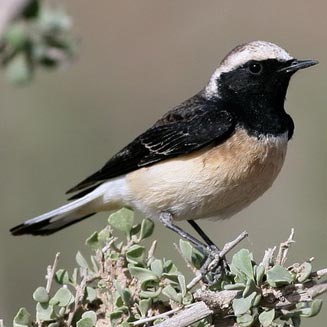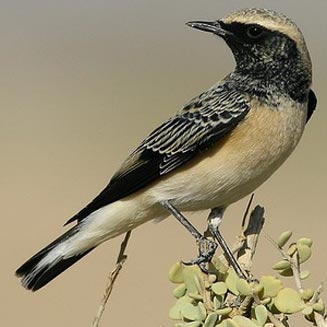|
Oenanthe pleschanka (Pied wheatear)
Bontskaapwagter [Afrikaans]; Bonte tapuit [Dutch]; Traquet pie [French];
Nonnensteinschmätzer [German]; Chasco-dominó [Portuguese]
Life
> Eukaryotes >
Opisthokonta
> Metazoa (animals) >
Bilateria >
Deuterostomia > Chordata >
Craniata > Vertebrata (vertebrates) > Gnathostomata (jawed
vertebrates) > Teleostomi (teleost fish) > Osteichthyes (bony fish) > Class:
Sarcopterygii (lobe-finned
fish) > Stegocephalia (terrestrial
vertebrates) > Tetrapoda
(four-legged vertebrates) > Reptiliomorpha > Amniota >
Reptilia (reptiles) >
Romeriida > Diapsida > Archosauromorpha > Archosauria >
Dinosauria
(dinosaurs) > Saurischia > Theropoda (bipedal predatory dinosaurs) >
Coelurosauria > Maniraptora > Aves
(birds) > Order: Passeriformes
> Family: Muscicapidae > Genus: Oenanthe
 |
 |
|
Pied wheatear male in breeding plumage, Kuwait.
[photo rashed11112
©] |
Pied wheatear male in non-breeding plumage,
Kuwait. [photo
rashed11112 ©] |
Distribution and habitat
It breeds from eastern Europe through to central Asia,
heading south in the non-breeding season to south-western Arabia and
north-eastern Africa, from Egypt to Somalia and Tanzania. It was once spotted in
a fallow sugar cane field at Mtunzini, KwaZulu-Natal, South Africa in 1984,
which is the only time it has ever been seen in southern Africa. It generally
prefers plains with scattered thickets and trees, boulder-strewn mountain
slopes, moorland, cliffs, dry cropland, stock pens and villages.
Food
It mainly eats insects, doing most of its foraging from a
perch, pouncing prey on the ground or hawking insects aerially. The following food items have been recorded
in its diet in Africa:
References
-
Hockey PAR, Dean WRJ and Ryan PG 2005. Roberts
- Birds of southern Africa, VIIth ed. The Trustees of the John Voelcker
Bird Book Fund, Cape Town.
|
